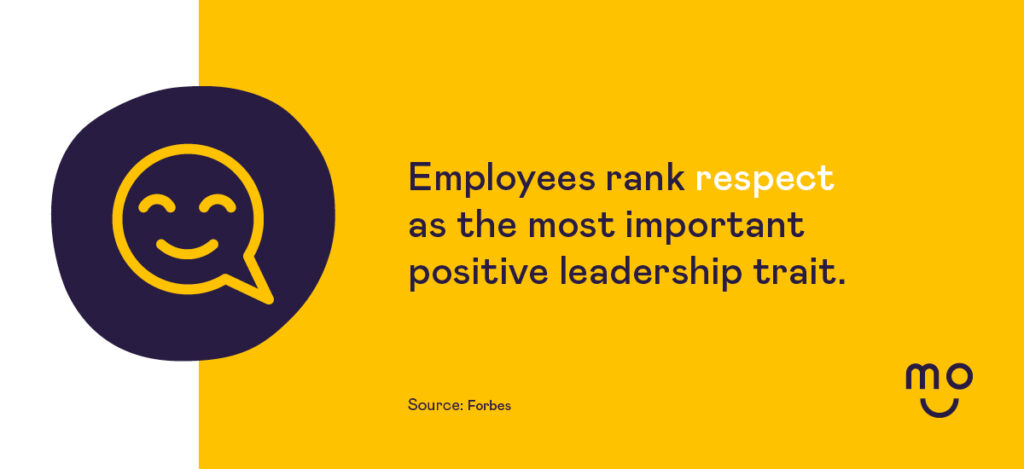Respect in the workplace is not a buzzword. It is the cornerstone of every working relationship. But when building a high-performing team, leaders often fail to address The Respect Gap, our preferred term to describe the gap between different perceptions of company culture.
Recent examples of conflict in top boardrooms, such as the turmoil at OpenAI, highlight the importance of mutual respect between colleagues. Respect is crucial for a positive work environment. A positive work culture has an uplifting effect on key business metrics, such as attrition rates.
You don’t have to be Sam Altman to struggle with conflict within your company. Most organisations encounter problems when personalities clash. Anger is rarely justified; even potentially apocalyptic technology should be planned and administered in a respectful environment.
Fostering a respectful atmosphere within teams can be difficult. In fast-paced environments, respect is an even greater priority. But every company, regardless of size, should prioritise respectful professional relationships.
Respect at Work is Essential
Our experts have witnessed the profound difference a positive work culture can make in attrition and productivity rates. Mo customers enjoy higher rates of engagement by aligning habits with values that prioritise employee experience.
If your company struggling to foster a culture of respect, it might be The Respect Gap at play. In this article, we define the discrepancy, as well as the many ways it manifests in team dynamics, to ensure your culture of respect can thrive.

Respect: What is it and Why is it Important?
Put simply, the definition of respect encompasses feelings of admiration towards an individual and consideration for their feelings, autonomy and rights. Employees will respond more favourably to managers who speak to them with markers of respect. These can include basic things, such as eye contact and active listening, and expand to more complex behaviours like delivering feedback constructively and letting them manage their own time.
Respect is particularly important in dynamics with unequal power structures. According to a report from Forbes, employees rank respect as the most important positive leadership trait. However, there is a large gap between owed respect and earned respect. Younger workers may not like old-fashioned hierarchies, making it crucial to achieve a culture of respect regardless of rank.
Mo Tip 👉 Many managers confuse conflict avoidance with respect. When leaders trust their employees to respond positively to constructive feedback, two things happen: 1. Problems are solved faster. 2. Employees build trust with their managers.
Lack of Respect Has Darker Implications
Research by Gallup found that levels of respect correlate with discrimination and harassment reports in the majority of cases. Many people who feel disrespected at work also face discrimination, such as harassment, in at least one of thirty-five ways. This applies to 90% of individuals.
On the extreme end of the spectrum, disrespectful behaviour can affect mental and physical health. Psychological safety is paramount in the workplace and some examples of a negative work environment can include:
- Constructive dismissals
- Quiet firing
- Harassment
- Passive aggressive communication
- Unrealistic demands
Since managers are a central factor in employee engagement levels, the way they communicate with their team can change the trajectory of an entire department.
Gallup recommends that managers give “coaching” sessions once a week, rather than relying on endless micromanagement. This method will not only boost engagement levels, it will also make employees feel trusted and, therefore, respected.
Transform your culture with Mo

- Improve employee engagement scores
- Reduce employee churn
- Build a collaborative culture
Respect at Work May Soon Be a Legal Issue
In July 2023, the Bullying and Respect at Work Bill was proposed in parliament. It was raised by Labour and Co-operative MP for York Central, Rachael Maskell. If the bill passes, it will create a new code for respectful workplaces while enforcing minimum standards, as well as including measures to prevent bullying at work.
Mo Tip 👉 With legislation on the table, it’s time to implement a positive work culture. If you’d like to talk to us about recognition and respect in your company, book a demo today.
The new legislation indicates a shift in priorities within the business world. Employees, regardless of industry, age and location, are demanding better working conditions. Employers would be amiss not to keep up with changing expectations.
The Respect Gap: Why It Matters
HR professionals who struggle to attain a culture of respect may notice a significant disconnect at the root of their work environment: The Respect Gap. We have expanded this term to describe a discrepancy between respect given by leaders and respect perceived by employees.
The Respect Gap happens when leaders believe they are paying employees due respect employees feel they are not receiving enough respect from leadership.
The resentment that builds as a result of The Respect Gap is detrimental to a positive culture, ultimately sabotaging productivity within teams. A lack of respect often emerges as a point of contention after an engagement survey but can be difficult to address.
Case Study: Nice vs Respectful
The Respect Gap indicates that leaders often mistake being nice for being respectful in a work environment. An example of this discrepancy can be seen in the recent rise of flexible work:
In this example, a high-level manager granted flexible working arrangements as a nice gesture, but then continued to call that employee at any time of day, requesting tasks outside of their preferred working hours.
When confronted with this behaviour, the manager responded:
“Why are you upset? I respected your desire for flexible work. I have been so nice and understanding.”
But what the leader failed to recognise is that granting a flexible working request might be a nice thing to do, but they need to trust their employee to complete their work within their chosen schedule. Demanding work at all hours, in addition to micromanaging, demonstrates a lack of respect.
Does this scenario sound familar? If you recognise this within your organisation, it might be time to change your management structures to avoid perpetuating The Respect Gap.
What is the Solution to The Respect Gap?
The first step towards closing The Respect Gap in your company is understanding different forms of respect and how they are received by employees.
In her article for Harvard Business Review, Kristie Rogers, a professor at Marquette University, says employees appreciate two types of respect: Owed Respect and Earned Respect.
Rogers emphasises that respect is essential for employees to flourish. A respectful atmosphere is one where people are free to be creative, cooperative, and resilient. They’re also more likely to be satisfied at work and loyal to their company. By recognising the two different types of respect necessary and finding ways to integrate them equally, you’ll be able to create a firm foundation for employees to grow and succeed.
What is Owed Respect?
- Owed respect is given equally to all members of an organisation.
- Owed respect is necessary for inclusivity. It assumes that everyone values and desires their team’s presence and perspective.
- Leaders can demonstrate this kind of respect by behaving civilly and politely. Companies that do not offer a level of baseline respect run the risk of making employees feel dispensable.
What is Earned Respect?
- This type of respect recognises the talents and achievements of an individual.
- To show earned respect, leaders must measure employee performance. It offers the opportunity to celebrate and reward employees for their achievements.
- When earned respect is lacking, you can expect low motivation and productivity levels from employees who feel undervalued.
Leaders should foster a culture where both types of respect are present and robust. If you only want respect for your title and not your actions, your employees may not be motivated to work hard. Your position alone may not be enough to inspire hard work from your employees.
Mo Tip 👉 It is important to earn respect through your actions and leadership. Employees are more likely to be motivated when they see their leader working hard and setting a good example. If the balance swings too far the other way, you can end up with a toxic culture of competitiveness and distrust.

5 Ways to Improve Respect in the Workplace
The Respect Gap highlights discrepancies between management and employee perceptions. Before trying to address any problems, conduct an employee engagement survey to create a comparable set of data points. Repeat the exercise in six months to assess your progress. During the interim, work on these five points of improvement:
1. Powers of Communication
There are two main ways of showing respect: words and actions. A strong communication style increases the likelihood that others will understand your intended meaning. Train your managers to use active listening and encourage them to prioritise coaching over micromanagement.
If you take action after an engagement survey, employees will feel affirmed that you value their opinions and well-being. Book a demo with our experts if you need support after a recent engagement survey. We can help you take action.
2. Empathetic Leadership
Becoming an empathetic leader will earn and promote respect in your workplace. Why? Empathy is all about understanding, allowing you to recognise and celebrate your team’s differences. While some respect must be earned for it to feel meaningful, managers often set the bar too high.
Another powerful way to make a change is to invest your energy into creating a human-centric culture, which naturally encourages openness and consideration.
3. A Growth Mindset
Showing employees that you respect, recognise and appreciate their contributions to company growth will encourage them to excel. Building a culture of recognition will encourage employees to meet their targets; when it comes to performance, we recommend the carrot over the stick.
A high-performing team starts with a solid foundation of respect.
4. Respect and Wellbeing
Respect, when given authentically, reduces stress and improves wellbeing. Micromanagement is the enemy of engagement. Why not try something different? Our software makes asynchronous recognition easy.
5. Improve Engagement
Cultivating a culture where employee engagement thrives is essential for any business – and respect is the perfect fertiliser. A survey by Harvard Business Review found that respect was the highest driver of commitment and engagement in employees. Engaged employees are happier and more productive.
Ready for the solution? Book a demo to discover the ways Mo can transform your workplace culture 🚀
The Respect Gap: Key Takeaways
- Respect may be an integral component of all interactions, but it’s especially important in the workplace. Employees who feel supported and respected are far more likely to excel and far less likely to suffer from stress.
- Create the kind of fun and nurturing workplace culture where respect is second nature, and you’ll see better levels of productivity, engagement and collaboration.
- When you’re looking for ways to integrate better communication, recognition and respect into your day-to-day, we’re here to help.

![[image] 4174782](https://mo.work/wp-content/uploads/2023/12/image-4174782-150x150.jpeg)


